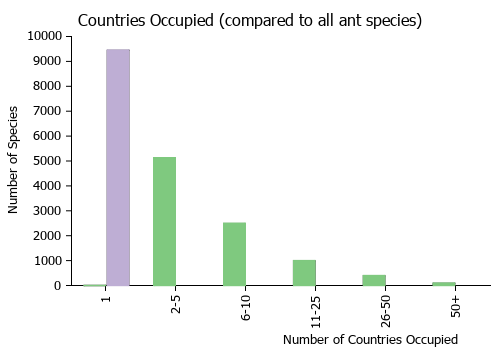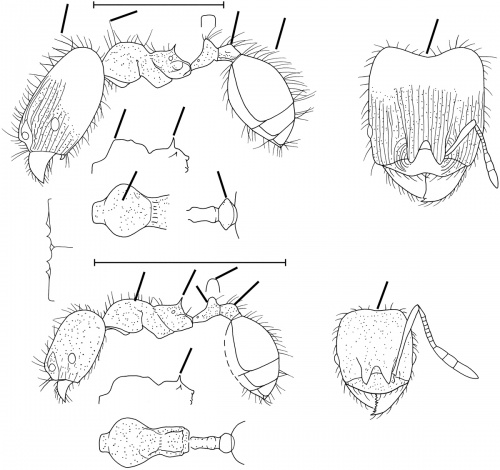Pheidole morelosana
| Pheidole morelosana | |
|---|---|
| Scientific classification | |
| Kingdom: | Animalia |
| Phylum: | Arthropoda |
| Class: | Insecta |
| Order: | Hymenoptera |
| Family: | Formicidae |
| Subfamily: | Myrmicinae |
| Tribe: | Attini |
| Genus: | Pheidole |
| Species: | P. morelosana |
| Binomial name | |
| Pheidole morelosana Wilson, 2003 | |
This species is only known from type specimens. Nothing is known about its biology.
Identification
See the description in the nomenclature section.
Keys including this Species
Distribution
Only known from the type locality.
Latitudinal Distribution Pattern
Latitudinal Range: 20.90938889° to 18.75°.
| North Temperate |
North Subtropical |
Tropical | South Subtropical |
South Temperate |
- Source: AntMaps
Distribution based on Regional Taxon Lists
Neotropical Region: Mexico (type locality).
Distribution based on AntMaps
Distribution based on AntWeb specimens
Check data from AntWeb
Countries Occupied
| Number of countries occupied by this species based on AntWiki Regional Taxon Lists. In general, fewer countries occupied indicates a narrower range, while more countries indicates a more widespread species. |

|
Estimated Abundance
| Relative abundance based on number of AntMaps records per species (this species within the purple bar). Fewer records (to the left) indicates a less abundant/encountered species while more records (to the right) indicates more abundant/encountered species. |

|
Biology
Castes
Phylogeny
 Varela-Hernández & Riquelme (2024), Fig. 3. The phylogenetic status of Pheidole praehistorica among fossil and extant congeners inferred from the list of characters (Supp. file 1: Table S1) and the data matrix (Supp. file 1: Table S2), shows the twenty-eight morphological characters to construct the most parsimonious tree. The numbers above the white and black dots represent morphological characters, and the numbers below represent the character encoding. Black dots represent synapomorphies, and white dots represent homoplasies. † represents fossil species from Dominican and Mexican amber. Consistency index = 0.52; retention index = 0.65.
Varela-Hernández & Riquelme (2024), Fig. 3. The phylogenetic status of Pheidole praehistorica among fossil and extant congeners inferred from the list of characters (Supp. file 1: Table S1) and the data matrix (Supp. file 1: Table S2), shows the twenty-eight morphological characters to construct the most parsimonious tree. The numbers above the white and black dots represent morphological characters, and the numbers below represent the character encoding. Black dots represent synapomorphies, and white dots represent homoplasies. † represents fossil species from Dominican and Mexican amber. Consistency index = 0.52; retention index = 0.65.
Nomenclature
The following information is derived from Barry Bolton's Online Catalogue of the Ants of the World.
- morelosana. Pheidole morelosana Wilson, 2003: 465, figs. (s.w.) MEXICO.
Unless otherwise noted the text for the remainder of this section is reported from the publication that includes the original description.
Description
DIAGNOSIS Pheidole morelosana is similar in various traits to Pheidole bilimeki, Pheidole floridana, Pheidole goeldii, Pheidole grex and Pheidole rectispina, distinguished as follows.
Major: dark yellow; occiput broad and deep; pilosity dense and very long, many hairs much longer than Eye Length; humerus subangulate in dorsal-oblique view; propodeal spines long, nearly vertical to propodeal basal face in dorsal-oblique view; promesonotal profile flat in side view; postpetiolar node very low in side view and spinose from above; mesosoma entirely foveolate and opaque.
Minor: eye small, oval; all of head and mesosoma foveolate and opaque; petiolar node broad and rounded at apex; postpetiolar node low; occiput broad, its margin concave.
MEASUREMENTS (mm) Holotype major: HW 0.78, HL 0.88, SL 0.42, EL 0.08, PW 0.44. Paratype minor: HW 0.44, HL 0.50, SL 0.42, EL 0.06, PW 0.28.
COLOR Major: concolorous dark yellow except for antennae and tarsi, which are pale yellow. Minor: concolorous medium yellow except for tarsi, which are pale yellow.
Figure. Upper: holotype, major. Lower: paratype, minor. Scale bars = 1 mm.
Type Material
MEXICO: Miacatlan, Morelos, col. A. B. Hamton. Museum of Comparative Zoology
Etymology
Named after the Mexican state of origin of the type colony.
References
- Wilson, E. O. 2003. Pheidole in the New World: A dominant, hyperdiverse ant genus. Harvard University Press, Cambridge, MA. (page 465, fig. major, minor described)
- Varela-Hernández, F., Medel-Zosayas, B., Martínez-Luque, E.O., Jones, R.W., De la Mora, A. 2020. Biodiversity in central Mexico: Assessment of ants in a convergent region. Southwestern Entomologist 454: 673-686.
- Varela-Hernández, F., Riquelme, F. 2024. Pheidole praehistorica sp. nov., a new addition to spiny ants of the genus Pheidole Westwood, 1839 (Formicidae, Myrmicinae) from Oligo–Miocene Mexican amber. European Journal of Taxonomy 968: 86-97 (doi:10.5852/ejt.2024.968.2719).
References based on Global Ant Biodiversity Informatics
- Dattilo W. et al. 2019. MEXICO ANTS: incidence and abundance along the Nearctic-Neotropical interface. Ecology https://doi.org/10.1002/ecy.2944
- Vásquez-Bolaños M. 2011. Lista de especies de hormigas (Hymenoptera: Formicidae) para México. Dugesiana 18: 95-133
- Wilson, E.O. 2003. Pheidole in the New World: A Dominant, Hyperdiverse Genus. Harvard University Press
